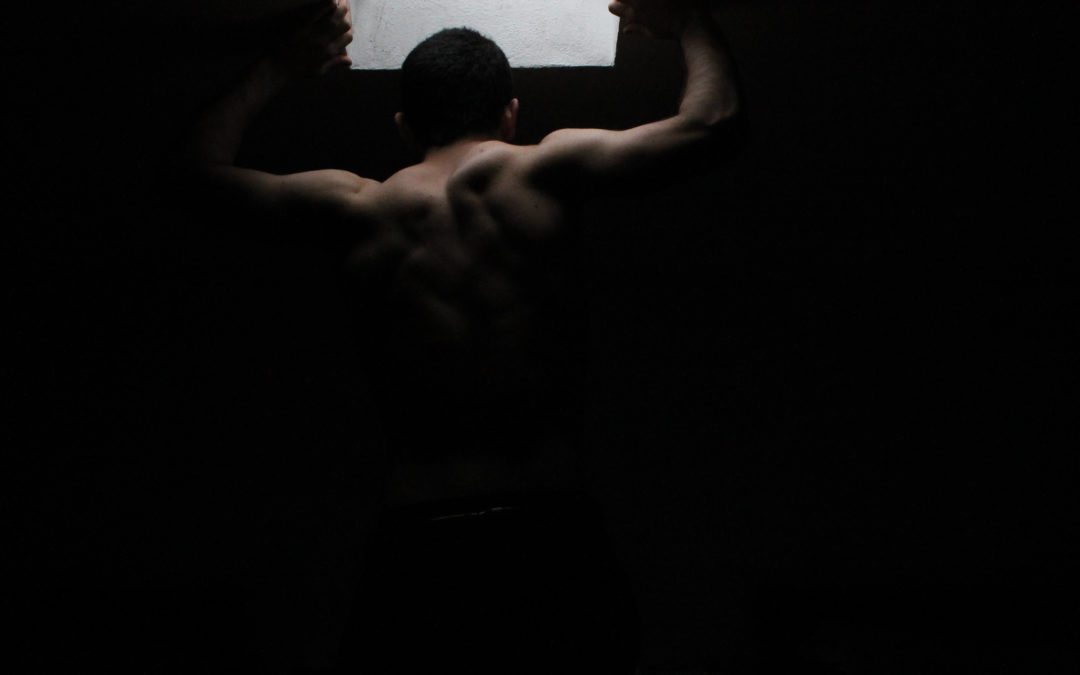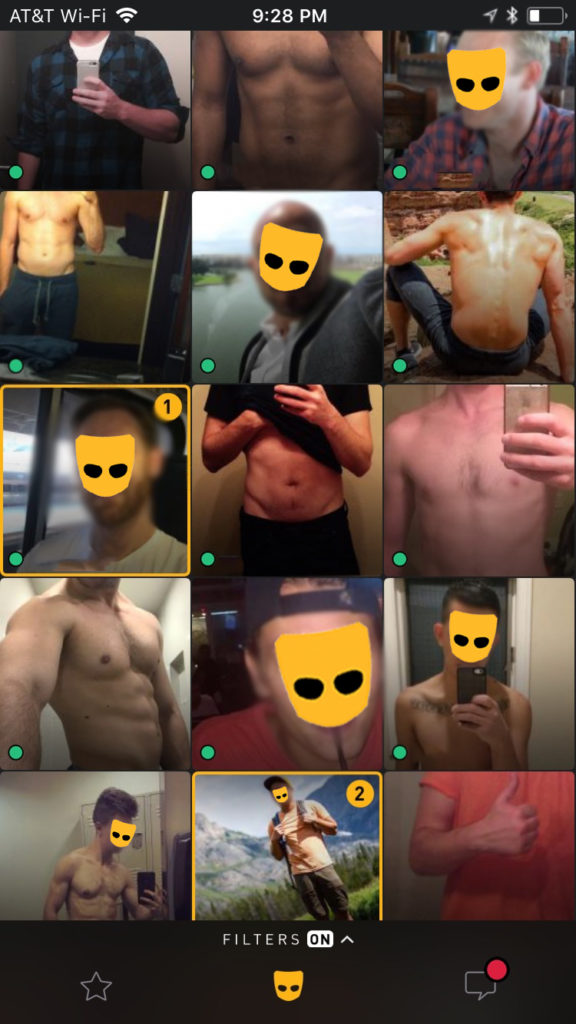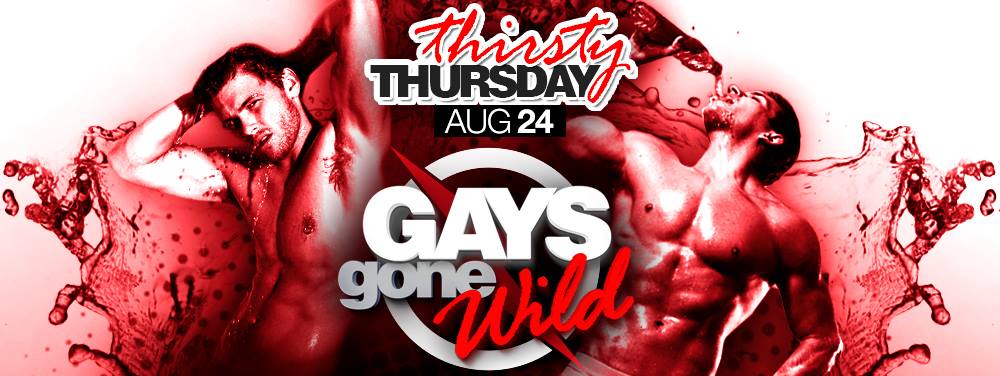Where can we find self-love in a culture of physical comparison?
Written by Ryan Achtman
PART I. Understanding The Culture
PART II. Identifying Our Impulses
PART III. Taking small steps
It’s Saturday of Halloween weekend. My friends and I have decided to head to the annual party at a local dance club.
I knew what to expect: loud music, heavily poured drinks, and men in revealing clothes.
I would be one of those men.
—
We’re at my place getting ready. I take off my shirt to drape on a scarf – the only piece of clothing that I will be wearing on the upper half of my body. My friend immediately says: “Damn, Ryan! Your abs look fantastic!”
I knew they did. I stare at them in the mirror at least four times a day.
Throughout the night, I got attention. Attention from guys who may have never, or at least hadn’t previously, paid me their energy. I was several times greeted with: “Wow, you look good!”
I’ve frequently been in these spaces and felt insecure—not tall enough, not toned enough, won’t get attention unless my hairy chest is on display—despite the fact that I exercise for at least an hour six times a week and eat a whole foods plant based diet. Despite, more importantly, the fact that we can’t choose our bodies’ heights or hair growth or natural weight distribution.
To prepare for Halloween weekend, I lifted more intensely at the gym, I ate more particularly, and I tried out some new forms of exercise (shout out to Pilates – you’re kicking my ass!).
In fact, since coming out two years ago, I have worked out harder than ever before.
Have you ever felt self-conscious about how you look in social spaces, especially gay male spaces? If so, it’s time to talk about it. If not, well, I’m truly happy for you.
Before I go further, I’d like to make a few explicit statements about my perspective: I am one human. One experience in one sub-community of another sub-community. Every time I say “gay community” or something similar, you can interpret it as “the subcommunity of the gay male community that I am a part of.”
I also want to acknowledge how privileged and fortunate I am in so many aspects of my life. I recognize how my socioeconomic status, my whiteness, my maleness/cisgenderness, and so on provide me more access to quality food, fitness facilities, and the gay communal spaces that are the focus of this piece.
I welcome your perspectives and experience in opposition and agreement.
Separate from our gender, race, sexuality and so on, the majority of us are plagued with body image issues. We are all exposed to the same superstars on our screens, the same organizations preaching the ‘right’ methods to eat and exercise, the same cultural obsession with the number on the scale.
The pressures that I have felt since coming out have no doubt given me a lens into what women experience every damn day.
However, the gay male culture that I am engaged with does carry a unique set of spaces where we are observing, comparing, and judging our physical bodies. In addition, I feel that the conversation of self-image is seldom had in this community, as well as in male communities more generally.
—
My first gay connections formed on Grindr.
If you’ve been on Grindr or any dating or hookup app, you know that there are lots of bodies on display. You have options to add your weight and height and body type (including “Toned,” “Muscular,” and “Average”, among others).
Some people’s profiles read “Masc men only. No twinks, no fats, no fems,” and so on. Fat-shaming, thin-shaming, femininity-shaming, racism, even—you guessed it—homophobia!
Even if we don’t explicitly state these “preferences,” how many of us carry relatable judgements towards others and ourselves?
I don’t blame these men. I do not blame us. Our views of others are reflections of the views of ourselves, and the views of ourselves have been dictated by years of fear, anger, shame and silent trauma.
The first gay bar I ever entered had three go go dancers placed in the center of the dance floor: buff, hairless men in tight underwear. Along the walls were posters for upcoming events, featuring more chiseled chests and perfectly toned cores. On the screens above the bar were images of big burly men with bulging muscles.
My first Pride weekend was spent at pool parties, parades, dances in the park, and giant club parties. At most of these places, men were shirtless, if not pants-less.
Photos from www.nycpride.org
Gay men have several other outlets to connect that likely involve less clothing than your average work day, including: beach towns, cruise ships, and social media (which is, of course, not a gay-only space, but can be filtered in such a way).
Gay communities do, in fact, have other wonderful spaces to engage: sports leagues, book clubs, and protests to name a few. However, for a community that has been brought up in judgement and shame, I see the value in celebrating sexual freedom through physical connection and dancing with minimal clothing—which can be seen as both deviant, but also biologically innocent and pure.
This piece is focused on recognizing the potential effect of these spaces and subsequent culture on our self-image, and ultimately, how we can move forward in self-love, individually and collectively.
—
There are so many reasons why these communal spaces were created and why they continue to exist: sexual repression, heteronormativity, ideals of masculinity. These contexts are incredibly important in understanding LGBTQ culture today.
For now, I’d like to briefly talk about the latter topic, masculinity, as this is a crucial piece to understanding how we view our communities and ourselves.
Our ideas of masculinity affect all men—gay and straight—in so many overarching ways. And let’s not forget how our engrained image of masculinity truly affects women. Yes, this topic definitely deserves more attention and energy than this article.
Men are taught to be tough (emotionless), strong (aesthetically strong) and assertive (cold and unapologetic). To be the opposite, to be ‘feminine,’ means we are too sensitive (emotionally intelligent), weak (have different body types), and timid (considerate and empathetic).
“Suck a dick,” “take it up the ass,” and much worse, were used by male classmates and friends as insults. Many gay males on television are portrayed as the best friends of females who love to shop. Through these overt experiences, consciously and unconsciously, we’ve been taught that being gay is inherently non-masculine.
Beyond these perhaps obvious examples of homosexuality as the antithesis to masculinity, we are also taught, through seemingly unidentifiable moments, that men should walk, talk and act a certain way. If you’ve ever thought that you or someone else speaks, stands, and walks “gay,” you know what I’m talking about.
If you’ve been privileged enough to change the pitch of your voice, or consciously tone down the sway of your hips, you probably have also thought about how you can exude your masculinity through your physical appearance.
How do we carry this compulsion to appear more ‘masculine’ and less ‘gay’ with us when we exit the closet?
The reality is that who we are and how we look or act are separate from our gender or sexuality. Every person carries a balance of traits historically viewed as “feminine” and “masculine.” We are smart and bold, timid and jealous, athletic and creative.
Gay males, especially white gay males, actually have an incredible opportunity: in many of our progressive cities and neighborhoods, we’ve been given the privilege to express our masculinity and femininity fully and authentically, which most straight men do not have. Are we finding significance in this privilege or going down a path of hyper-masculinity?
In many of the spaces I’ve discussed, I see the latter.
This hyper-masculinity—a conscious, extreme journey in contrast to what we’ve been conditioned to believe that ‘gay’ looks like—can manifest itself as very scary things, including depression, anger, and body image issues.
All of this, of course, is not to say that your love of football, or beer, or muscular hairy men is inauthentic. I am challenging you to challenge yourself as to whether or not it is and why, but more importantly, to examine how it affects the way you view yourself.
Let’s acknowledge some natural laws of attraction.
Physical attraction is a piece of attraction. It makes sense that an app designed for conveniently located hookups is dictated by physical appearance.
The question is: how much of what we view as physical attractiveness has been dictated by the forces around us?
There is no clear answer.
It would make sense that we begin to idolize the physiques of men we see dancing at our bars, raking in thousands of likes on Instagram, and those who get paid to have sex on film. We are taught that in order to be wanted, desired, we have to look a certain way.
Again, I point no fingers. As a community, spending a lifetime in shame and fear, before and after coming out, this cultural epidemic is not our fault.
But, if we care about the betterment of ourselves, and the betterment of others, we have to recognize our unhealthy patterns and begin a process of shifting these to healthy thoughts and actions.
Next, let’s talk about health.
The four pillars of long term wellness are diet, exercise, sleep, and stress relief. It is undoubtedly true that exercise and food are important to our health. The key is finding balance and authenticity in this quest towards overall wellness.
Some questions are:
- Are we shifting our focus from health to pure aesthetics?
- Are we actually damaging our bodies rather than strengthening them?
- Are we creating more states of negative mental health than positive physical health?
- Are we allowing too much of our self-worth to be dictated by our exterior? Are we valuing appearance over intellect, kindness, values, etc.?
Again, there are no definite answers to these questions. Everybody and every body is different.
—
Identifying body image issues
Still with me?
Without judgement or blame, but with honesty, consider that the following could be signs that you have an imbalanced relationship with your body or with food:
- Obsessing over what you’re eating. Ate pizza for lunch? Are you still thinking about it an hour later? 5 hours later?
- Touching your body compulsively. I regularly tug at my right oblique because I’ve always been self-conscious about the (very natural) fat on the side of my waist.
- Talking about or thinking about the body of someone else in a judgmental way. Or, making a judgement about someone’s character or worth based on their physical appearance. This is likely a displacement of your own thoughts on your body.
- Talking about or thinking about your own body in a judgmental way. How many times have you heard, seen, or posted things like the following:
“Pride is coming up! Time to starve myself for the next two weeks.”
“Why can’t I have a six pack like that?”
“I love your hairy chest, but I shave mine.”
“Time to work on my PV body!”
“Ugh, I haven’t gone to the gym all week.”
Words and thoughts matter. If you’re pouring energy into guilt and jealousy, you may have some body image issues to work out.
- Working out just before going out. Pushups, crunches, a jog. These exercises are likely doing nothing for us in the long term, but they do give our bodies a nice pump before hitting the bars, and we know it.
- You’re injured or fatigued for a long period of time.
- Using unnatural methods of body transformation. Steroids, laxatives, purging, chemical-heavy pre-workout, starving yourself and so on. In other words, putting unnatural things into your body or doing unnatural things to your body to obtain unnatural results.
—
Where do we go from here?
Naturally, the solution to our body image issues are case by case, but I feel there are some principles and actions that we all can take to reach a healthier body image.
Start from within.
I’m not suggesting that we should break the system, mostly because I don’t know that we can, at least in one tectonic motion. There are too many years, systems, structures in place that have built the culture we experience today. However, we can start making behavioral and mindset shifts from smaller foundations: within ourselves.
Regardless of how cliché it sounds, the real work is inside. If you cannot find contentment from within, no matter how tight your core is or how defined your thighs are, you will never be satisfied. We need to shift our focus from external appearance to internal beauty.
At the same time, it is natural to accept that our outward appearance does affect the way we are seen in today’s society. It’s an unfortunate reality, but we are not helpless. We can find balance and deeply care for ourselves within this culture.
How can we begin to make this shift?
- Empathize. This is perhaps the most important principle to find happiness anywhere and everywhere in our lives, within our bodies and beyond.
Outwardly, empathy can be manifested by speaking positively of others and actively listening in conversations. Internally, we can show empathy by taking time to consider how, despite differences in background, experiences, and dispositions, we are similar to those around us. Recognize that we are all works in progress, in and out—the stick, the Adonis, the belly and everything in between—we are wrestling or have wrestled with our self-perceptions.
If sharing the fact that we are human beings doesn’t create enough of a bridge, perhaps more fundamental to this population, appreciate that as gay men, we have all struggled or continue to struggle with our sexualities and the adversity we’ve experienced in our relationships with family, friends, coworkers, strangers, and ourselves internally.Let’s use this knowledge to be more friendly, kind and less superficial.
- Focus on your talents and passions. Your true worth lies in your interests and hobbies, your work and your kindness. When you spend a larger percentage of your energy on what you can contribute to this world through your talents and passions, you develop a greater connection to humanity and in effect, a greater value of self.
- Be kind to yourself. Don’t beat yourself up because you didn’t go to the gym this week. Eat the damn ice cream! Make decisions, make mistakes, accept them and learn from them. Don’t linger on them. Honor your successes. You are beautiful and worthy, always and forever.
- Dive below the surface. All transformation begins with analysis.
We all—simply by being human—experience fear, anger, insecurity.Take time, perhaps with paper and pencil, to dive into the things you dislike and really like about yourself.
Beyond looking at your current self, take some time to consider how past experiences in your life, not related to fitness or food, affect you every day. Death, humiliation, the quality of our relationships.
There are so many healthy ways to help you deal with the things happening inside, and perhaps dug quite deep. Therapy, meditation, and focusing on your passions are some potentially effective solutions.
- Find inspiration, not comparison. It is healthy to look at someone and say “They look good” and “What they’re doing is cool!” We run into self-deprecation when we flip the narrative to “Why don’t I look like that?” or “I’ll never do something like that.”
You’re right! They are them and you are you. Find inspiration or care in the physiques, diets, and activities of others, but anchor your goals on your power, your potential, and your worth (which is quite high).
I’ve heard that “comparison is the killer of creativity.” I’d also propose that comparison is the killer of joy and self-worth.
- Reframe your social media. Social media is ruining our self-esteem. You know it, I know it, we all know it. Social media showcases filtered, refined versions of the lives of others and encourages us to show off the very best and prettiest moments of our own lives.
Clenching your fist to show off your biceps? Being a little too generous with the Structure setting on Instagram? Checking in every time you go to the gym? Consider how these photos and posts not only allow yourself to be defined by your physicality, but how they also create false narratives for your followers and yourself on our wellness journeys.
Listen, I’m no saint. I feel that rush of dopamine from attention on social media. The key is to understand that these are short-term states of elation.
If you can’t imagine deleting or stepping back from your apps, in the least, be actively mindful that what you are seeing is hand-picked, edited, scripted content, and a ‘like’ will never replace a hug, a smile, a real-time interaction.
- Commit to a lifetime of balanced wellness. Forget short-term dieting, binging, and two-a-days at the gym when Pride is around the corner. Begin to incorporate wellness into your every day, week, month, and year in balanced ways.
As stated, the four basics of overall wellness are: diet, exercise, sleep and stress relief. They are equally important and work in tandem. If you’re not getting enough quality hours of sleep, no matter how well you’re eating and exercising, this will affect your long term health.
I want to once again state that everyone experiences wellness differently. Habits that can be considered healthy for one person can be very harmful for another person. As well, health covers a huge span of body shapes and sizes.
Wellness is about how we feel, not about how we look.
Diet
Diet, it seems, can be the hardest of these structures to build for the long run. We are encouraged to have pre-packaged meals delivered to our doors or we might eat out a lot. We are constantly being swarmed by the latest fad, and there are so many opinions from Western and Eastern medicine that point us in different directions. “Diet”—what we consume—has become synonymous with “diets”: structured, restrictive systems that dictate our eating.
I’ve struggled with my diet for a long time. I had an eating disorder through most of high school and the beginning of college that involved avoiding all fat (congrats, sugar industry! Your marketing tactics worked on me). Since becoming a *mostly vegan 4+ years ago, I’ve finally found a healthy relationship with food.
It takes trial and error, and a ton of patience, to find out what foods work well with your body, but the ultimate result is worth your energy.
Exercise
Exercise is a modern day phenomenon. Humans used to move, simply through the work we did: chasing prey, harvesting crops. Today, many of us spend much more time in sedentary states: hunched over computer screens, binging Netflix from the comfort of our couches. To incorporate movement into our (much too) fast-paced and sedentary lifestyles, we’ve created spaces dedicated to exercise.
When it comes to finding the right type and amount of exercise for our bodies, we must honestly examine our motives.
Are we working on strength? Flexibility? Heart health or stress relief? Are we working on big biceps, six packs and nice thighs because we think it’s attractive?
When our motives shift from health to aesthetics, we are doing a disservice to our self-worth. But, again, as members of this physically-driven society, we can realize that two motives are not mutually-exclusive. If we are focusing on the way we look or the number on a scale, are we doing so in a way that cares for our bodies and psyches?
Exercise, like diet, is filled with so many systems and routines that can be contradictory. My advice: step outside your comfort zone and find exercises that you enjoy—lifting alone at the gym, group fitness, hiking, skiing, walking—and do them with care and kindness. As Lexie would say, move joyfully.
Sleep
There are many proven ways to improve our quality and amount of sleep. Some include:
- Turn off screens at least one hour before bedtime
- Keep devices out of the bedroom
- Limit your caffeine intake in the afternoon
- Block out time to sleep the amount your body needs (your body will tell you how much that is if you listen)
- Set up a bedtime ritual: read, write, drink tea
Stress Relief
Stress relief can tie into many of these other elements. Exercise can reduce anxiety, but if we are obsessing over exercise, it can actually have the opposite effect. Food can help the functionality of our organs, which can regulate the release of toxins and waste from our bodies. Sleep has an obvious effect on our stress levels. How good does it feel to wake up from a long, deep slumber?
There are other ways to specifically focus on stress relief. One of the most popular methods is a systematic focus on mindfulness and meditation. There are apps that provide guided mindfulness practices. Not your thing? Spend five minutes focusing on a slow breath in and out. Another stress relieving activity is creative production: writing, drawing, cooking! Have some fun.
Cross-dimensional wellness
The four pillars of wellness feed off each other, and there are a number of opportunities for these elements to exist together. I find a convergence of exercise, stress relief, and sleep within yoga. Depending on the form, you can experience strength building, mindful breath work, and calming rest within 1 hour of practice. Where do you find intersections between the pillars of wellness?
—
Final thoughts
We live in a larger society, and in many ways, a tiny subculture, that considers the way we look as the most important aspect of our self-worth.
It is our right, our obligation to flip that hierarchy through the ways we interact with ourselves and others. Surviving years of criticism, confusion, and adversity, we and those around us deserve that.
There is no quick fix to body image issues. Like anything else, we have to take small steps. Where can we grow, introspect, push consciously and safely, and where can we settle, calm, and accept?
Most importantly: how can we be better to each other and how can we be better to ourselves?






Recent Comments